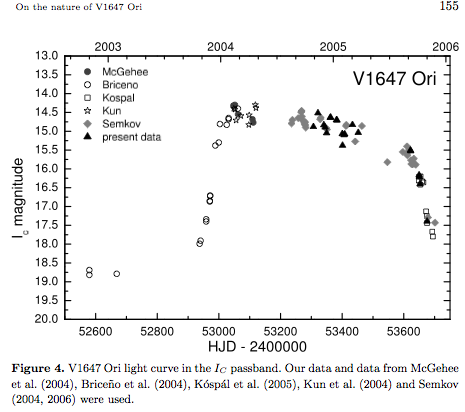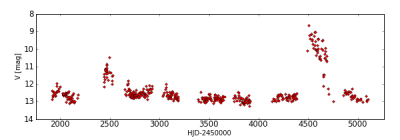Difference between revisions of "Triggers:FUOri"
Aleks.scholz (talk | contribs) |
|||
| (3 intermediate revisions by the same user not shown) | |||
| Line 1: | Line 1: | ||
| − | == | + | == Eruptive YSOs == |
| − | FU | + | |
| + | Prototypes: | ||
| + | |||
| + | FU Oris are an extreme subsample of eruptive classical T Tauri stars. Only one outburst observed, but lasts for decades. Only about a dozen FU Ori bursts observed. V1647 Ori is illuminating a McNeil's nebula in the vicinity of NGC 2068 star-forming region. | ||
[[File:FUOri.png]] | [[File:FUOri.png]] | ||
Plot from [http://www.ta3.sk/caosp/Eedition/FullTexts/vol36no3/pp149-157.pdf D.Chochol et al. 2006]. | Plot from [http://www.ta3.sk/caosp/Eedition/FullTexts/vol36no3/pp149-157.pdf D.Chochol et al. 2006]. | ||
| + | |||
| + | EX Lupis (EXors) have smaller, shorter, recurrent outbursts. | ||
| + | |||
| + | [[File:ExLupi.png|right|400px|thumb|EX Lupi photometry from the ASAS project.]] | ||
| + | |||
| + | OO Ser was discovered in 1994 and is similar to FUors and EXors, but is so deeply embedded, that at its brightest was not visible in J band ([http://ukads.nottingham.ac.uk/abs/1996ApJ...468..861H Hodapp et al. 1996]). | ||
| + | It was observed in infrared with ''Infrared Space Observatory'' and Spitzer ([http://arxiv.org/abs/0705.1231 Kospal et al. 2007]). | ||
| + | It has different time scales than FUors and EXors, is rather a ''fast'' FUor (similar to V1647 Ori) with a time of rise of about 8 months. | ||
Characteristics: | Characteristics: | ||
| − | * | + | * diverse zoo of lightcurves, use of templates is risky |
| − | * | + | * many details unknown, unbiased sample required |
| − | * | + | * rise time varies from months to years |
| − | * | + | * amplitude range from <1 mag to 5 mag (but 1mag cutoff is probably useful) |
| − | * Spectra: F or G supergiants | + | * outburst last from months to decades, some are recurrent |
| − | + | * extreme events like FU Ori are very rare | |
| + | * Spectra: F or G supergiants, red, heavily veiled continuum with strong emission of <math>H_{\alpha}</math> | ||
* At maximum spectral types are in the range Ae(alpha) - Gpe(alpha) | * At maximum spectral types are in the range Ae(alpha) - Gpe(alpha) | ||
* X-ray variability present | * X-ray variability present | ||
| Line 18: | Line 30: | ||
* FU Ori and V1515 Cyg decline over 20-100 years, V1015 Cyg decays faster (10 yrs) | * FU Ori and V1515 Cyg decline over 20-100 years, V1015 Cyg decays faster (10 yrs) | ||
| − | + | Trigger is necessary, because immediate follow-up (on timescales of weeks) needed to study the impact of | |
| + | such accretion bursts on the properties of the dust and gas in the disks. Also, high cadence monitoring | ||
| + | immediately after the event is useful for modeling the source. | ||
| − | * | + | Identification: |
| + | * >1mag rise in magnitude | ||
| + | * red spectrum, any spectral type | ||
| + | * J-K>1. IR excess, UV excess | ||
| + | * IRAC3 [5.8mu] - IRAC4 [8.0mu] > 0.4 | ||
| + | * WISE1 [3.5mu] - WISE4 [22mu] > 2.0 | ||
| + | * WISE1 [3.5mu] - WISE2 [4.5mu] > 0.3 (weak criterion) | ||
| + | * Halpha emission | ||
| − | + | References: | |
| − | |||
| − | + | * Hartmann & Kenyon 1996 review: http://adsabs.harvard.edu/abs/1996ARA%26A..34..207H | |
| − | + | * Scholz et al. 2013 systematic survey: http://adsabs.harvard.edu/cgi-bin/bib_query?arXiv:1301.3152 | |
| − | + | * Clarke et al. 2005 with example lightcurves (Fig. 1): http://adsabs.harvard.edu/abs/2005MNRAS.361..942C | |
| − | |||
| − | * | ||
| − | |||
| − | |||
| − | |||
| − | |||
| − | |||
| − | |||
| − | |||
Latest revision as of 15:09, 24 July 2013
Eruptive YSOs
Prototypes:
FU Oris are an extreme subsample of eruptive classical T Tauri stars. Only one outburst observed, but lasts for decades. Only about a dozen FU Ori bursts observed. V1647 Ori is illuminating a McNeil's nebula in the vicinity of NGC 2068 star-forming region.
 Plot from D.Chochol et al. 2006.
Plot from D.Chochol et al. 2006.
EX Lupis (EXors) have smaller, shorter, recurrent outbursts.
OO Ser was discovered in 1994 and is similar to FUors and EXors, but is so deeply embedded, that at its brightest was not visible in J band (Hodapp et al. 1996). It was observed in infrared with Infrared Space Observatory and Spitzer (Kospal et al. 2007). It has different time scales than FUors and EXors, is rather a fast FUor (similar to V1647 Ori) with a time of rise of about 8 months.
Characteristics:
- diverse zoo of lightcurves, use of templates is risky
- many details unknown, unbiased sample required
- rise time varies from months to years
- amplitude range from <1 mag to 5 mag (but 1mag cutoff is probably useful)
- outburst last from months to decades, some are recurrent
- extreme events like FU Ori are very rare
- Spectra: F or G supergiants, red, heavily veiled continuum with strong emission of <math>H_{\alpha}</math>
- At maximum spectral types are in the range Ae(alpha) - Gpe(alpha)
- X-ray variability present
- FU Ori and V1057 Cyg rise over 1 yr, whereas V1515 Cyg rise over 20 years
- FU Ori and V1515 Cyg decline over 20-100 years, V1015 Cyg decays faster (10 yrs)
Trigger is necessary, because immediate follow-up (on timescales of weeks) needed to study the impact of such accretion bursts on the properties of the dust and gas in the disks. Also, high cadence monitoring immediately after the event is useful for modeling the source.
Identification:
- >1mag rise in magnitude
- red spectrum, any spectral type
- J-K>1. IR excess, UV excess
- IRAC3 [5.8mu] - IRAC4 [8.0mu] > 0.4
- WISE1 [3.5mu] - WISE4 [22mu] > 2.0
- WISE1 [3.5mu] - WISE2 [4.5mu] > 0.3 (weak criterion)
- Halpha emission
References:
- Hartmann & Kenyon 1996 review: http://adsabs.harvard.edu/abs/1996ARA%26A..34..207H
- Scholz et al. 2013 systematic survey: http://adsabs.harvard.edu/cgi-bin/bib_query?arXiv:1301.3152
- Clarke et al. 2005 with example lightcurves (Fig. 1): http://adsabs.harvard.edu/abs/2005MNRAS.361..942C
